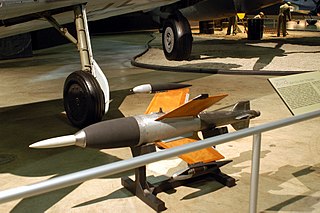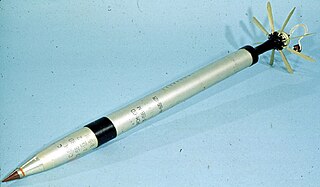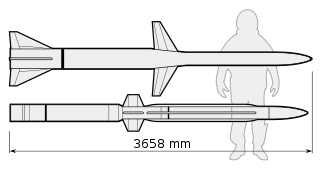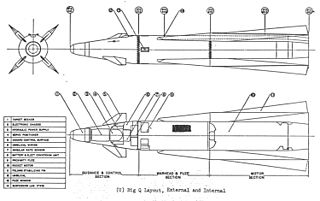
R4M, abbreviation for Rakete, 4 kilogramm, Minenkopf, also known by the nickname Orkan due to its distinctive smoke trail when fired, was a folding-fin air-to-air rocket used by the Luftwaffe at the end of World War II.

Rheintochter was a German surface-to-air missile developed by Rheinmetall-Borsig during World War II. Its name comes from the mythical Rheintöchter (Rhinemaidens) of Richard Wagner's opera series Der Ring des Nibelungen.
Rheinbote was a German long range ballistic rocket developed by Rheinmetall-Borsig at Berlin-Marienfelde during World War II. It was intended to replace, or at least supplement, large-bore artillery by providing fire support at long ranges in an easily transportable form.

The Ruhrstahl Ru 344 X-4 or Ruhrstahl-Kramer RK 344 was a wire-guided air-to-air missile designed by Germany during World War II. The X-4 did not see operational service and thus was not proven in combat but inspired considerable post-war work around the world, and was the basis for the development of several ground-launched anti-tank missiles, including the Malkara.

The PGM-17A Thor was the first operational ballistic missile of the United States Air Force (USAF). Named after the Norse god of thunder, it was deployed in the United Kingdom between 1959 and September 1963 as an intermediate-range ballistic missile (IRBM) with thermonuclear warheads. Thor was 65 feet (20 m) in height and 8 feet (2.4 m) in diameter. It was later augmented in the U.S. IRBM arsenal by the Jupiter.

The PGM-19 Jupiter was the first nuclear armed, medium-range ballistic missile (MRBM) of the United States Air Force (USAF). It was a liquid-propellant rocket using RP-1 fuel and LOX oxidizer, with a single Rocketdyne LR79-NA rocket engine producing 667 kilonewtons (150,000 lbf) of thrust. It was armed with the 1.44 megatons of TNT (6.0 PJ) W49 nuclear warhead. The prime contractor was the Chrysler Corporation.

Seaslug was a first-generation surface-to-air missile designed by Armstrong Whitworth for use by the Royal Navy. Tracing its history as far back as 1943's LOPGAP design, it came into operational service in 1961 and was still in use at the time of the Falklands War in 1982.

The Malkara was one of the earliest guided anti-tank missiles (ATGMs). It was jointly developed by Australia and the United Kingdom between 1951 and 1954, and was in service from 1958 until gradually replaced by the Vickers Vigilant missile in the late 1960s. It was intended to be light enough to deploy with airborne forces, yet powerful enough to knock out any tank then in service. The basic form was later adapted for the short-range surface-to-air role as the Seacat and influenced the development of the Ikara.

The S-5 is a rocket weapon developed by the Soviet Air Force and used by military aircraft against ground area targets. It is in service with the Russian Air Force and various export customers. It is based on a German design from World War 2.

The RP-3 was a British air to ground rocket projectile introduced during the Second World War. The "3 inch" designation referred to the nominal diameter of the rocket motor tube. The use of a 60-pound (27 kg) warhead gave rise to the alternative name of the "60-pound rocket". Though primarily an air-to-ground weapon, it saw limited use in other roles. They were generally used by British fighter-bomber aircraft against targets such as tanks, trains, motor transport and buildings, as well as by Coastal Command and Royal Navy aircraft against U-boats and ships.

The AIM-152 AAAM was a long-range air-to-air missile developed by the United States. The program went through a protracted development stage but was never adopted by the United States Navy, due to the ending of the Cold War and the reduction in threat of its perceived primary target, Soviet supersonic bombers. Development was cancelled in 1992.

The AIM-68 is an American air-to-air missile design. It never entered production.

The Lavochkin La-250 "Anakonda" was a high-altitude interceptor aircraft prototype developed in the Soviet Union by the Lavochkin design bureau in the 1950s. Its nickname "Anaconda" was invented during the flight test and referred to both the elongated body shape as well as the relatively critical flight characteristics of the machine.
RS-82 and RS-132 were unguided rockets used by Soviet military during World War II.
In addition to developing the C-101 and C-301 supersonic anti-ship missiles which are fairly large in size, China has developed FL-7 supersonic anti-ship missile which can be carried on airplanes and warships. The Feilong-7 has an effective range of 32 kilometers and a speed of Mach 1.4. It has powerful anti-jamming capability and its supersonic flight makes terminal interception difficult. The warhead of the FL-7 can pierce solid armor and destroy large and medium-sized surface warships. This missile can be roughly considered as the supersonic counterpart of the subsonic C-704 anti-ship missile. The missile is powered by a liquid fuel rocket motor and a solid rocket booster, which is under the airframe at the rear.

The Nimrod is a long-range air-to-surface missile developed by Israel Aerospace Industries. While primarily designed for anti-tank use, it provides standoff strike capability against a variety of point targets such as APCs, ships, bunkers, personnel concentrations and guerrillas.
The AS-25K is an Argentine air-to-surface missile (ASM) under development by the CITEFA in two versions: air-to-sea and air-to-land. The main user is the COAN of the Argentine Navy.

ALAS is a Serbian long-range multipurpose wire guided missile system developed by the private company EdePro and the state-owned Yugoimport SDPR. The ALAS missile system was developed primarily for missions against tanks, armored vehicles, fortifications, command posts, low-flying helicopters, coastal ships, industrial facilities and bridges. It can be deployed by any suitable platform including helicopters, armored vehicles, small ships and infantry. The guidance system is based on video/infrared technology, with the missile connected to the launcher by a fiber-optic cable. The ALAS flies at low altitude and has small radar and infrared (heat) signatures due to using a turbofan motor instead of a turbojet. In recent years, the ALAS platform has found a secondary use as a UAV.
There have been a number of 18-inch torpedoes in service with the United Kingdom.
The BMW 109-558 is a liquid fuelled sustainer rocket motor developed by BMW at their Bruckmühl facility, in Germany during the Second World War.















